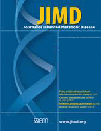A trial with N-carbamylglutamate may not detect all patients with NAGS deficiency and neonatal onset
Communicating editor: Nenad Blau
Online citation: JIMD Short Report #050 (2007) Online
Electronic Supplementary Material:
The online version of this article (doi:10.1007/s10545-007-0454-9) contains supplementary material, which is available to authorized users.
Summary
N-Acetylglutamate synthase (NAGS) deficiency is a rare urea cycle disorder. An effective treatment, N-carbamoyl-l-glutamic acid (NCGA), is now available, increasing the importance of identifying and treating these patients early. We describe a case with genetically verified NAGS deficiency and neonatal onset of severe hyperammonaemia. The ammonia levels increased above 1400 μmol/L. The patient did not respond to NCGA treatment during the first 15 h, indicating that a delayed response or no response cannot be used as a safe indicator for excluding NAGS deficiency in the acute situation. Hence, conventional treatment should not be delayed by a diagnostic procedure, such as a loading test. Furthermore, at 3 years of age this patient has normal psychomotor development, underlining the possibility of a favourable outcome despite markedly elevated ammonia levels, coma, and seizures in the neonatal period. Including NCGA early in the treatment of patients with hyperammonaemia may be of clinical importance. In order to detect patients with NAGS deficiency and neonatal onset and to optimize care, it is important to use the available treatment strategies to reduce plasma ammonia concentrations without delay. We propose the use of combined symptomatic treatment, i.e. glucose infusion, sodium benzoate, arginine or citrulline, and when indicated haemodialysis, as well as NCGA treatment in all neonates presenting with severe hyperammonaemia. The treatment should be continued until laboratory investigations are complete or indicate another disorder.




